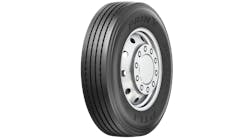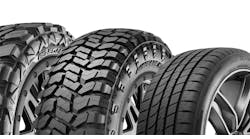Goodyear Tire & Rubber Co. posted net income of $157 million on net sales of $3.8 billion for the second quarter ended June 30, 2018. That compares to income of $147 million on sales of $3.7 billion in the second quarter of fiscal 2017. The company’s income-to-sales ratio for 2Q 2018 was 4.1%.
Segment operating income was down 12%, from $369 million to $324 million. Tire unit volume was up 4% worldwide. The company said the decrease was driven by the impacts of higher raw material costs, general cost inflation and lower price/mix, which were partially offset by the benefits from cost savings initiatives and increased sales volume.
Replacement tire shipments rose 5%, attributable to increased industry demand and share gains in the EMEA region (Europe, Middle East, Africa). Original equipment unit volume was up 3%, primarily driven by consumer demand in Asia Pacific and global commercial shipments. Goodyear said consumer replacement shipments in the U.S. outpaced industry growth after adjusting for the impact of the TireHub transition, driven by outperformance in the 17-inch-and-larger category.
In the Americas business unit, second-quarter tire unit volume was up 2%. The tire volumes break down as follows:
- Replacement tire shipments rose 1.5%, led by strength in the U.S. despite the impact of transitioning to TireHub.
- Original equipment unit volume was up 2%, driven by growth in both commercial and consumer fitments.
- The company estimates that a national transportation strike in Brazil restricted growth in the Americas by about 1.5%.
Sales of $2 billion were down slightly from the year-ago period, reflecting unfavorable foreign currency translation and reduced price/mix.
Segment operating income totaled $154 million, down from $218 million, or 29%, from the same period in 2017. The decline was driven by the impact of reduced price/mix and increased raw material costs. The lower price/mix reflects the impact of last year’s price reductions, which were partially offset by strong growth in the U.S. within the 17-inch-and-larger category.
“We delivered strong operating performance in the quarter highlighted by impressive volume growth in our mature markets where we regained share, particularly in the more profitable 17 inch and greater rim sizes in the U.S. and Europe,” says Richard Kramer, chairman, chief executive officer and president. “Additionally, we achieved our price/mix and net cost savings goals for the quarter.”
“While our execution in the period was robust, macro headwinds are intensifying – including rising raw material costs, a stronger U.S. dollar and softening market conditions in China. We are adjusting our plans accordingly to mitigate the impact of these challenges over the intermediate-term. I remain confident that our strengthening position in the marketplace, along with value created through our strategic initiatives, will allow us to deliver on our 2020 plan."
Tire Hub launch is on track
“Our new TireHub distribution joint venture in the U.S. is performing exceptionally well out of the gate, and our shipments to the wholesale channel are running ahead of our transition plans. Goodyear’s customer base has demonstrated its loyalty to our brand and I am confident that TireHub’s best-in-class service model, together with added supply from our new Americas plant, will enhance value for our retail and fleet customers,” says Kramer.
Profit falls in first half versus year-ago period
For the first six months of 2018, Goodyear posted net income of $232 million on net sales of $7.7 billion. That compares to net income of $313 million on sales of nearly $7.4 billion for the first half of fiscal 2017. First half segment operating income was down 25% to $605 million versus $759 million a year ago. Goodyear said the decrease was attributable to the effect of higher raw material costs and reduced price/mix.
Tire unit volumes were up 1%, from 77.4 million to 78 million, which Goodyear says was driven by stronger consumer replacement shipments in EMEA as well as increased consumer OE demand in Asia Pacific and higher global commercial shipments. Replacement tire shipments increased 1%. Original equipment volume was essentially flat.


